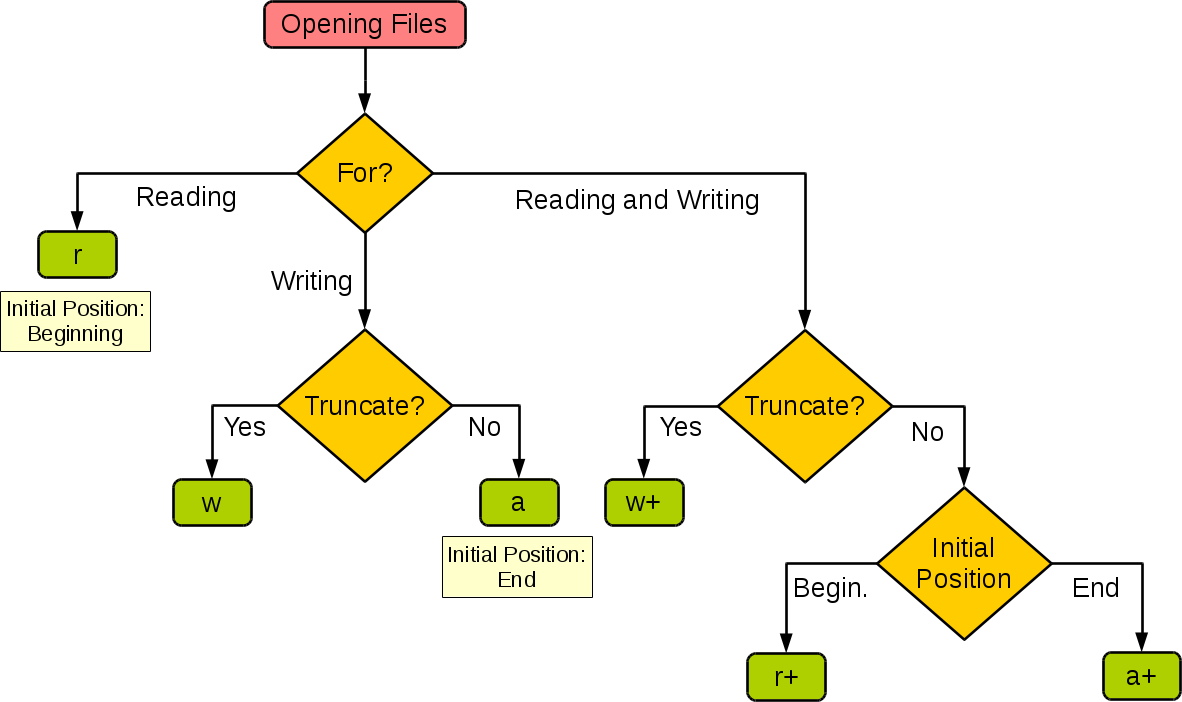Difference between modes a, a+, w, w+, and r+ in built-in open function?
In the python built-in open function, what is the exact difference between the modes w, a, w+, a+, and r+?
-
Same info, just in table form
| r r+ w w+ a a+ ------------------|-------------------------- read | + + + + write | + + + + + write after seek | + + + create | + + + + truncate | + + position at start | + + + + position at end | + +where meanings are: (just to avoid any misinterpretation)
- read - reading from file is allowed
write - writing to file is allowed
create - file is created if it does not exist yet
trunctate - during opening of the file it is made empty (all content of the file is erased)
position at start - after file is opened, initial position is set to the start of the file
- position at end - after file is opened, initial position is set to the end of the file
Note:
aanda+always append to the end of file - ignores anyseekmovements.
BTW. interesting behavior at least on my win7 / python2.7, for new file opened ina+mode:
write('aa'); seek(0, 0); read(1); write('b')- secondwriteis ignored
write('aa'); seek(0, 0); read(2); write('b')- secondwriteraisesIOError讨论(0) -
The options are the same as for the fopen function in the C standard library:
wtruncates the file, overwriting whatever was already thereaappends to the file, adding onto whatever was already therew+opens for reading and writing, truncating the file but also allowing you to read back what's been written to the filea+opens for appending and reading, allowing you both to append to the file and also read its contents讨论(0) -
I think this is important to consider for cross-platform execution, i.e. as a CYA. :)
On Windows, 'b' appended to the mode opens the file in binary mode, so there are also modes like 'rb', 'wb', and 'r+b'. Python on Windows makes a distinction between text and binary files; the end-of-line characters in text files are automatically altered slightly when data is read or written. This behind-the-scenes modification to file data is fine for ASCII text files, but it’ll corrupt binary data like that in JPEG or EXE files. Be very careful to use binary mode when reading and writing such files. On Unix, it doesn’t hurt to append a 'b' to the mode, so you can use it platform-independently for all binary files.
This is directly quoted from Python Software Foundation 2.7.x.
讨论(0) -
The opening modes are exactly the same as those for the C standard library function
fopen().The BSD fopen manpage defines them as follows:
The argument mode points to a string beginning with one of the following sequences (Additional characters may follow these sequences.): ``r'' Open text file for reading. The stream is positioned at the beginning of the file. ``r+'' Open for reading and writing. The stream is positioned at the beginning of the file. ``w'' Truncate file to zero length or create text file for writing. The stream is positioned at the beginning of the file. ``w+'' Open for reading and writing. The file is created if it does not exist, otherwise it is truncated. The stream is positioned at the beginning of the file. ``a'' Open for writing. The file is created if it does not exist. The stream is positioned at the end of the file. Subsequent writes to the file will always end up at the then current end of file, irrespective of any intervening fseek(3) or similar. ``a+'' Open for reading and writing. The file is created if it does not exist. The stream is positioned at the end of the file. Subse- quent writes to the file will always end up at the then current end of file, irrespective of any intervening fseek(3) or similar.讨论(0) -
I hit upon this trying to figure out why you would use mode 'w+' versus 'w'. In the end, I just did some testing. I don't see much purpose for mode 'w+', as in both cases, the file is truncated to begin with. However, with the 'w+', you could read after writing by seeking back. If you tried any reading with 'w', it would raise an IOError. Reading without using seek with mode 'w+' isn't going to yield anything, since the file pointer will be after where you have written.
讨论(0) -
I noticed that every now and then I need to Google fopen all over again, just to build a mental image of what the primary differences between the modes are. So, I thought a diagram will be faster to read next time. Maybe someone else will find that helpful too.
 讨论(0)
讨论(0)
- 热议问题

 加载中...
加载中...